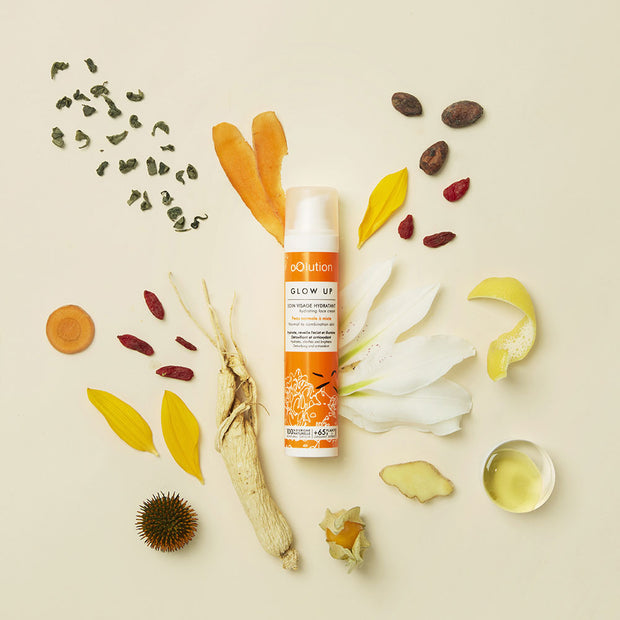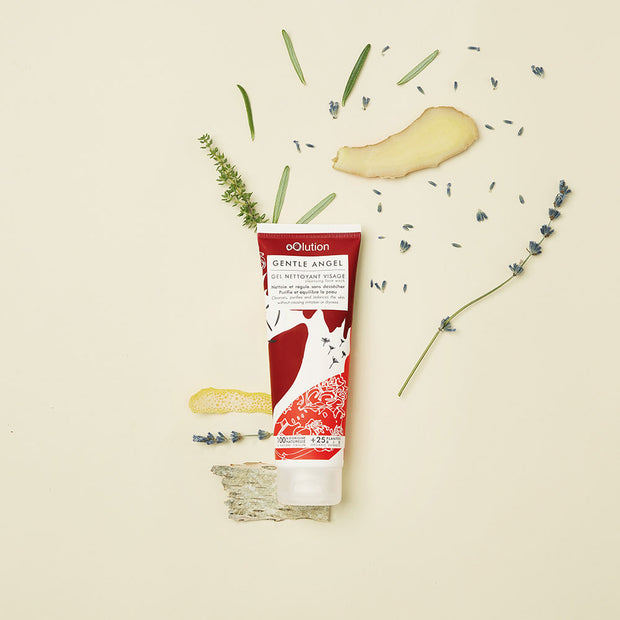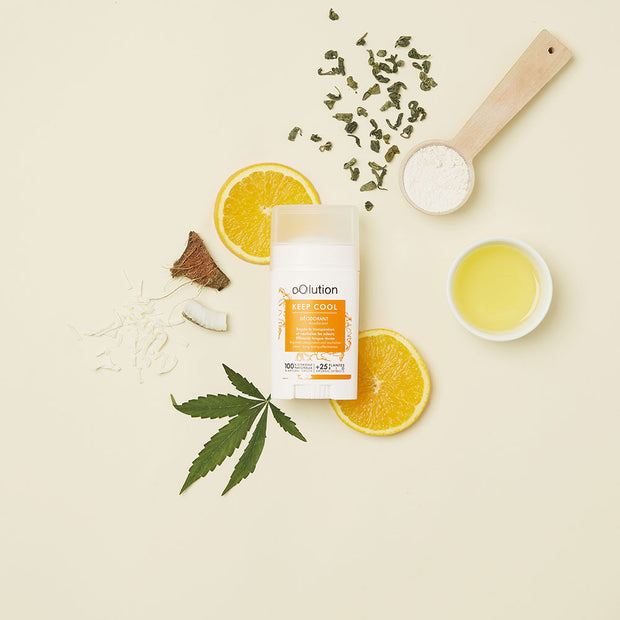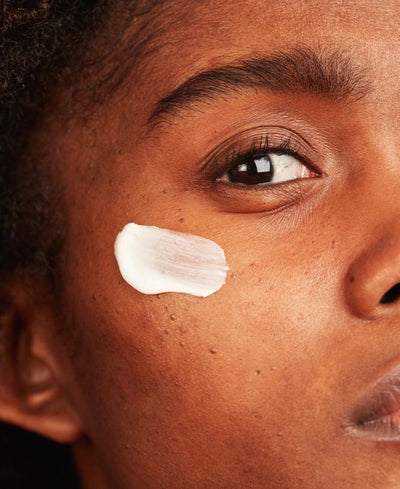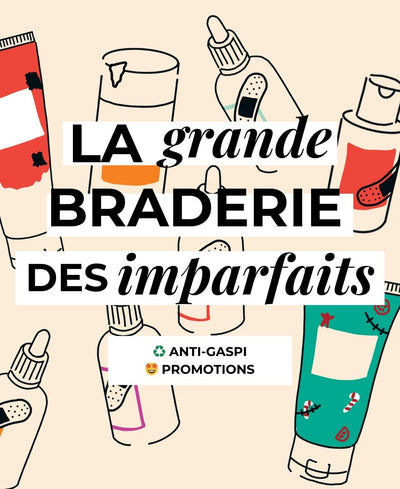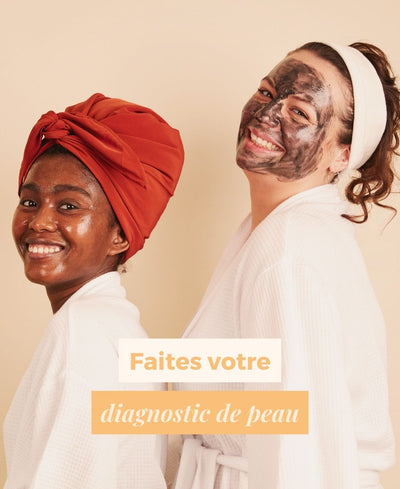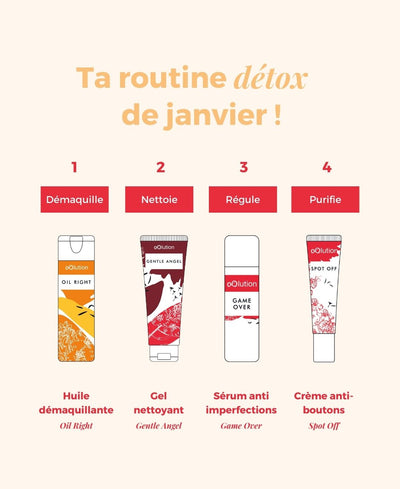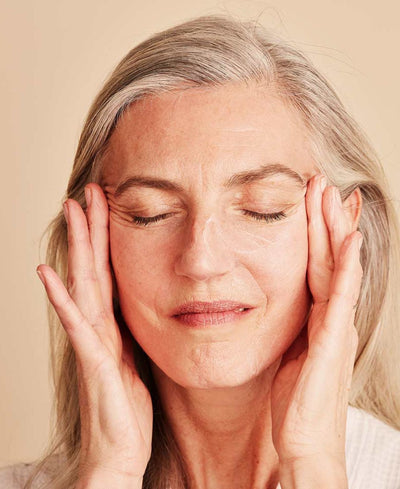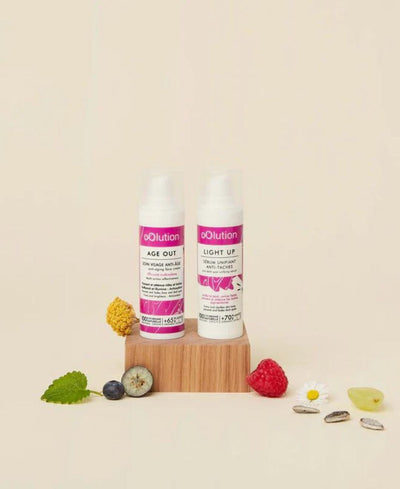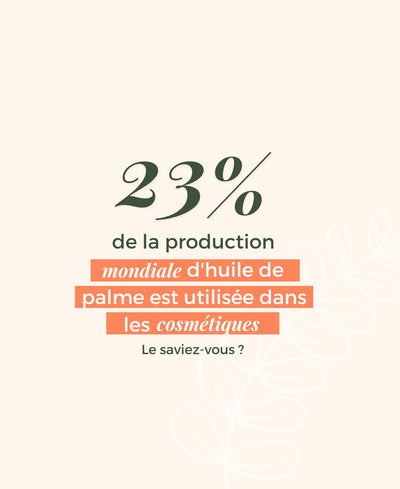We'd been promised an end to pimples and blackheads at the end of puberty, and now that pesky acne has taken up residence on the skin of our face, back and décolleté. In France, acne affects 40% of women over the age of 25*. Let's take a look at the most common causes of acne and the natural solutions to help you regain healthy skin. Of course, this advice is also for those who are still experiencing the joys of juvenile acne!

Adult acne: the golden rules to get rid of it!
Written on Feb.17.15 by Jade Billon - Updated on 02.Sep.22
40 years old and still full of pimples: I can't take it anymore!
Causes of adult acne
Hereditary For hereditary reasons, the sebaceous glands can be a little too sensitive to hormonal changes. This is the case for the vast majority of people suffering from recurrent blemishes. Thanks Mum and Dad!
Menstruation If you don't keep track of the dates of your cycles, the appearance of an enormous pimple at least tells you that it's that time of year! Shortly before menstruation, the ovaries produce progesterone, which stimulates sebaceous gland activity, a breeding ground for blemishes.
The pill: There are two possible effects of contraception. Either the pill contains nortestosetrone, which may cause acne. Or it may contain an estrogen and an anti-male hormone progestin, which will attenuate the effects of acne. But as soon as you stop taking the pill, the problem returns with a vengeance. In this case, we advise you not to panic and to wait 6 to 12 months for a return to normal. Follow the advice given in this article. To find out more: Help, I've stopped taking the pill!
Stress: Many nerve cells are located near the sebaceous glands, which increase sebum production when stressed. Since acne itself is a source of stress, it's not long before the snake is biting its own tail. So it's best to avoid focusing on pimples, and opt instead for a sporting or relaxation activity.
Contact acne
There are a thousand and one types of acne, and in many cases, it's not caused by hormonal imbalances, but by skin contact with irritating substances or clumsy gestures. This is known as contact acne, the most common forms of which are :
Cosmetic acne: ah, well, well! Do our cosmetics give us pimples? That's what we're talking about today: spotting the pitfalls and adopting the right precautions.
Chloracne: intoxication due to chlorinated agents themselves contaminated with dioxins. Severe chloracne is a rare disorder, reserved for workers in certain environments. But we'll see a little later why it can come from our bathroom.
To find out more, read our article on contact acne: Contact acne: what routine should you adopt?
What causes cosmetic acne?
First and foremost, acne-prone skin is not necessarily oily skin, just as oily skin is not necessarily acne-prone. The first thing to do is determine your skin type, to avoid choosing unsuitable skincare products.
If your skin is oily, combination to oily, or combination to oily with a tendency to dehydration, our article on skin care for oily skin will be very useful.
Overly aggressive cleaning
We say it again and again: whatever your skin type, you need to opt for gentle cleansing. Even on acne-prone skin, sebum is necessary, so let's stop the witch-hunt: grainy scrubs will only aggravate the problem!
Aggressive cleansers and grainy scrubs: stop the hygiene obsession
Skin is not impure: if it needs to be washed for good hygiene, there's no point in scrubbing it! We studied the compositions of a number of cleansing products for acne-prone skin sold in supermarkets and drugstores. The cleverest had removed the best-known sulfated detergents and replaced them with other, equally dubious surfactants (PEG 40, polysorbate, etc.). But we did find a whole host of sodium lauryl/laureth sulfate... These sulfated detergents are highly effective for lathering and scrubbing garage floors, but not for caring for your skin. They destroy the hydrolipidic film that protects and regulates the skin... What could be more normal than skin that defends itself by producing even more sebum, which we're trying to get rid of when it needs it so badly?
Read our full article on sulfated detergents and their dangers in cosmetics.
Opt for organic and natural cosmetics: the vast majority of products bearing the organic label guarantee a composition free from sulfated detergents and aggressive, even dangerous, surfactants. Take the time to study the different specifications of organic labels.
Another gesture that can cause damage: the false good idea of the grainy scrub. One form of cosmetic acne is so-called mechanical acne, which can develop as a result of mechanical aggression on the skin. Enzymatic scrubs (chemical action scrubs), on the other hand, are already gentler. But we'd still advise you to wait until your skin is regulated and soothed before using them.
Instead, we opt for a gentle solution: the good old facial sauna and its sidekick, the clay mask, have proved their worth. For the former, place your towel-covered head over a bowl of hot water containing a few drops of tea-tree, lavender, sage or lemon essential oil. For the second, prefer the mix-it-yourself powder version, as ready-made versions can be full of unsavory preservatives.
Occlusive and comedogenic ingredients in our skincare products
In conventional cosmetics, most manufacturers use silicones, mineral oils and waxes (kerosene) to give the illusion of hydration. I say "illusion of hydration" because cheap synthetic ingredients or petrochemical derivatives do nothing to benefit the skin. At most, the inert, impermeable film they deposit on the skin will help retain water (hydration), but will not hydrate it per se. That's why they're called occlusive agents, and why they're criticized for being comedogenic: they clog pores and ultimately asphyxiate the skin. While they pose no real health problems, their release into the environment after cleansing has a definite environmental impact, since they are not biodegradable. All good reasons to avoid them for good.
I'd like to take this opportunity to remove any doubt from your mind: these ingredients are used by everyone, from supermarkets to luxury perfumeries and parapharmacies. Parapharmacy is even very fond of emollients derived from mineral oils, including silicones. By the way, don't be fooled by an "oil-free" label, which does not mean the absence of mineral oil.
Read our full article on mineral oils in cosmetics.
Make-up
With this in mind, beware of conventional make-up! Especially complexion products (foundations, compact powders) which are full of petroleum-derived oils and waxes. We prefer... mineral make-up, which has nothing to do with petrochemicals but is of natural origin.
To camouflage a pimple, you can use an antidark shadows after disinfecting it (Tea-tree essential oil diluted invegetable oil). To matify your skin throughout the day, apply a little loose powder with a brush, then wash off weekly with soap and water.
Find out more: Acne make-up: How to apply make-up to acne-prone skin?
Treating cosmetic acne
There are many ways to treat acne. In some cases, acne requires medical treatment. We therefore advise you to make an appointment with a good dermatologist to identify the causes of your acne and discuss the most suitable solution (and beware if he or she suggests an internal treatment after 5 minutes of consultation!) In any case, our natural advice can't do you any harm and will be a great complement.
Start with gentle, natural cleaning
The option tested and approved by the oO team for skin cleansing: hydrolats. Soothing chamomile floral water, for example, is enough to remove impurities caused by air pollution and make-up residue. There's also the option of 100% natural cold-saponified soap , which still contains its glycerine and won't dry out the skin. A gentle cleansing gel is also a solution for purifying your face without attacking it. If you wear make-up on a daily basis, a make-up remover based on sweet almond or jojoba vegetable oil will remove your waterproof make-up wonderfully. Complete your cleansing with a pshitt of lavender, rose or witch hazel hydrosol: its astringent properties will keep your skin healthy all day long. Yes, it's that simple. Two natural and economical solutions that are kind to skin and the environment!
A gesture for the planet and for the skin: people whose work exposes them to tar and chlorine develop contact acne quite easily. Chlorine is toxic to the skin, and is commonly used to whiten the make-up remover discs found in our bathrooms... The environmental impact of these products is considerable: they consume a lot of water, and their production uses large quantities of pesticides... For pieces of cotton that are finally thrown away after one use. Switch to reusable make-up remover wipes, and your skin and the planet will thank you.
Choose the right active ingredients for your cream moisturizer
If your skin is suffering from acne (and it probably is if you're reading this), it needs to be cleansed and soothed. How do pimples form? Initially, a simple blackhead: the pore is blocked by excess sebum and takes on this dark hue through oxidation. This is a fertile breeding ground for bacteria, which tend to transform a blackhead into a red, painful pimple, or a white-tipped pustule.
On the assets side, you'll need to look for :
- Anti-bacterial active ingredients: what started out as simple clogged pores spread to the face due to bacteria (which is why we recommend not touching your face too much, for example).
- Anti-inflammatory active ingredients: a pimple is initially a comedo in a state of inflammation, which is how it becomes large, painful and leaves marks.
- Active ingredients rich in vitamin E: it soothes the skin, helps it defend itself thanks to its anti-oxidant properties and, above all, accelerates the healing of residual marks. Check that your cream contains extracts of Mimosa Tenuiflora and Centella Asiatica, for example.
All these properties are found in the essential fatty acids, rich in omega 3-6 and 9, of which... sebum is composed. So you'll need to choose skincare products formulated with plant oils rich in these fatty acids, which the body assimilates perfectly. You'll find them in ready-to-use skincare products, like our Check Matte, specially formulated to overcome imperfections.
You can also make your own homemade anti-acne serum: a mixture of vegetable oils and a few drops of essential oils will suffice. Be careful with essential oils: start gently and try to follow a recipe recommended by a specialist!
Here are a few examples of oils to use in your skincare products or homemade serums:
- Vegetable oil from hemp, Brazil nuts, linseed, black cumin, etc.
- Essential oil of lavender, tea tree, carrot, etc.
2 tips for optimum results:
- Choosing organic ingredients Organic oils: of course, we advise you to choose organic oils. Better still, first-pressed oils: you're guaranteed to get oils that still have all their virtues. Avoid hydrogenated and esterified oils, which have lost some of their benefits through processing.
- Think synergy and variety of active ingredients The skin is a complex organ requiring multiple inputs to function properly. That's why we always recommend using a variety of active ingredients. But there's no need to go into over-sophisticated blends at home (because that would be far too expensive, and because some of the oils could expire before use), as each oil contains an interesting complex of active agents.
What to do with a lesion that has already set in?
As we've seen, blackheads are an ideal breeding ground for bacteria. It's best to get rid of them with a well-sterilized blackhead remover (at the dermatologist's or at home). But pustules can appear without having gone through the initial blackheading process, and without you receiving 20,000 francs. This is typically the sign of stressed, weakened skin.
So what should you do? Avoiding triturating it will be a good start! Don't try to dry it out by draining it, but rather to sanitize it. You can usetea tree essential oil, for example,whose anti-bacterial properties will prevent the pimple from contaminating the rest of the skin. You'll then need to be patient and work in depth (like adopting the beauty routine recommended in this article...).
Beauty is in the plate
It's often said that our diet is a powerful beauty ally. First of all, essential fatty acids are as beneficial when applied to the skin as when swallowed. They are found in oleaginous fruits (walnuts, hazelnuts) and vegetable oils. Certain trace elements are also useful in the fight against acne. Selenium stimulates the immune system, and its action coupled with vitamin E (also found in oilseeds and vegetable oils) is recognized as effective against acne. Just one brazil nut a day is enough to meet our selenium needs - it's that simple! Finally, zinc helps heal lesions, and is found in lentils, dried beans, GMO-free soybeans and mushrooms.
Do certain foods cause acne? Specialists' reviews differ: but recent studies highlight the role of refined products (white bread, sweets) in acne formation, as they stimulate sebum production.
Questions about the article? A little advice to ask? We'd be delighted to hear from you in the comments!Sources :* An epidemiological study of acne in female adults: results of a survey conducted in France
Recommended products
